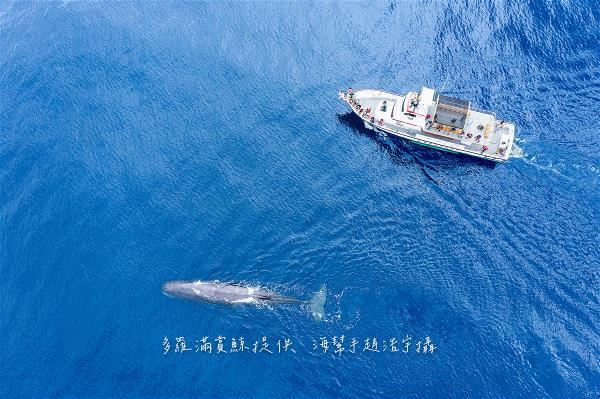2025-8-21
(Courtesy of Taiwan Panorama August 2025)
Cathy Teng /photo by Turumoan Whale Watching Company /tr. by Bob Dougherty
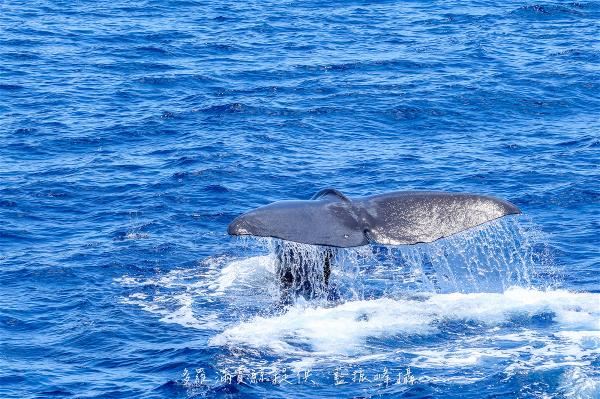
In early July, Taiwan’s online whale-watching community was issuing surprise updates about whale sightings every few days. The highly prized killer whale, not seen for three years, had appeared in the waters off Eastern Taiwan. Sightings of sperm whales quickly became a daily occurrence, with sperm whale calves actively approaching boats. Even a rare tropical bottlenose whale showed up. Was all this a response to summer festivities in Taiwan?
The boat slowly sets out from Hualien Harbor towards the vast Pacific Ocean, packed with tourists eager to catch a glimpse of sperm whales. Although Hualien Formosa Association founder Liao Hong-chi jokes that he used to get carsick even on a bullock cart, he now climbs to the highest point of the boat on every trip out to sea, scanning the vast ocean with binoculars in search of the telltale spouts of surfacing sperm whales.
This five-hour journey within 12 nautical miles of Taiwan’s shores is part of the “Visit the Pacific Sperm Whale π Project.” Since the project’s maiden voyage in 2023, these expeditions have focused on locating sperm whales wintering in the waters around Taiwan. They also record the species, locations, and sounds of cetaceans found in waters off the East Coast, data that shows that Taiwan has an abundance of cetacean resources.
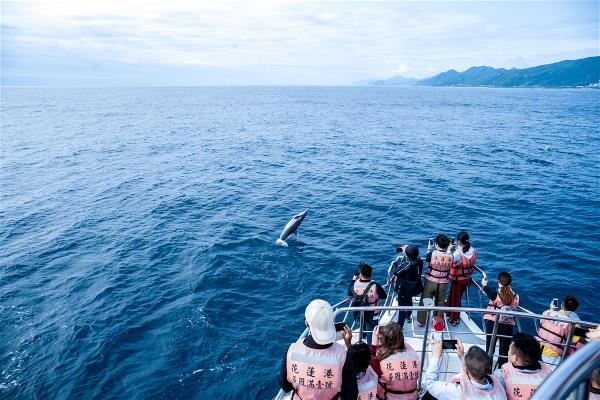
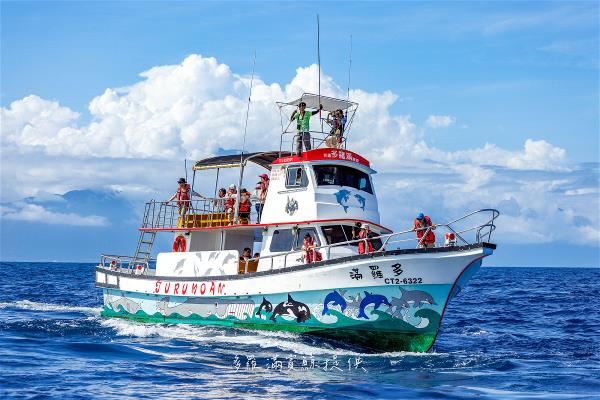
Whale ahoy!
In 1997 Liao Hong-chi began promoting whale-watching activities. In 1998 he founded the Kuroshio Ocean Education Foundation to promote ecotourism, train guides, and collaborate with commercial whale-watching boats to bring the ocean classroom directly on deck. Hualien became the birthplace of whale-watching activities in Taiwan, and over time, a mechanism for sea captains to report cetacean sightings developed. “Within the first hour of a two-hour whale-watching trip, basic coastal species are usually sighted within five nautical miles offshore, including spinner dolphins, pantropical spotted dolphins, and Risso’s dolphins.” Adventurous captains then began to explore further to see what other cetaceans live within Taiwan’s territorial waters. “After 2018, sightings of sperm whales gradually increased.”
Sperm whales and humpback whales are internationally recognized as large whales, and Liao Hong-chi explains that if those two species appear in the surrounding waters, you can proudly say that your country has world-class marine biological resources.
Humpback whales migrate long distances close to the continental shelf, which makes them easier to observe and study. Although they once chose the waters off the Hengchun Peninsula as their wintering ground, unrestricted hunting in the past made humpback whales virtually extinct in the waters surrounding Taiwan. For unknown reasons, sperm whales, which inhabit deeper waters, are still present, but our understanding and research are superficial. If Taiwan could provide evidence that sperm whales appear in the surrounding waters, this would attract international attention, and thereby attract more international scholars and friends to visit.
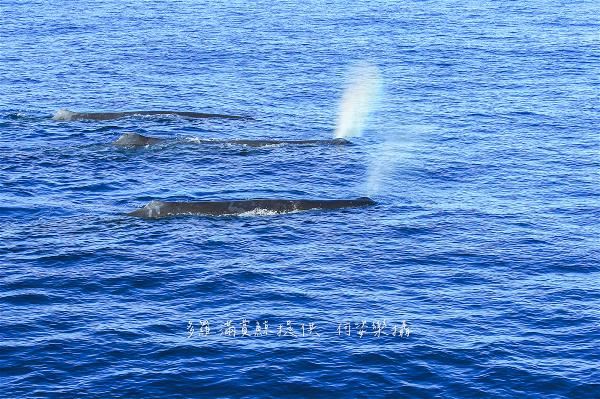
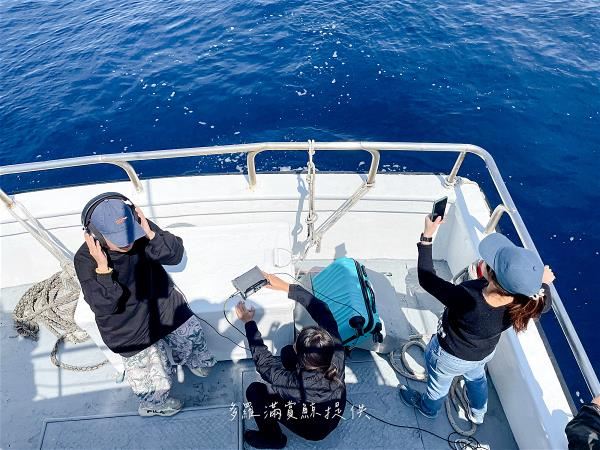
A project is born
Responding to the urgent need for cetacean surveys, the ever-proactive Liao quickly established the Hualien Formosa Association to spearhead the “Visit the Pacific Sperm Whale π Project.” A collaboration with the Turumoan Whale Watching Company, the project is expected to require 540 hours at sea over three years. Volunteers with expertise in various fields have been recruited from the community to record data from each outing, including still images, video, aerial photography and underwater imaging, as well as GPS waypoint vessel tracking data, with underwater microphones used to collect voiceprint data on cetaceans. All of these methods will be employed to search for sperm whales and establish a cetacean observation database.
The project name uses the mathematical symbol π (pi) to express three distinct meanings. First, when a sperm whale lifts its tail high out of the water as it begins a deep dive, the flukes (lobes) of the tail resemble the π symbol. Second, π represents an infinite, non-repeating decimal, symbolizing the endless expanses of the sea. Third, the underwater topography off the eastern coast of Taiwan, facing the Pacific Ocean, also resembles π: the main island forms the upper horizontal stroke, with the Luzon island group extending southeast forming one of the lower vertical strokes, and the Ryukyu Islands extending northeast forming the other. The Kuroshio Current flows along the inner edges of this π-shaped figure, triggering an upwelling that supports a large marine ecosystem. Liao Hong-chi explains that migratory marine animals visit this area every year, and the two vertical strokes of the π figure are wide open, symbolizing that we welcome these creatures with open arms.
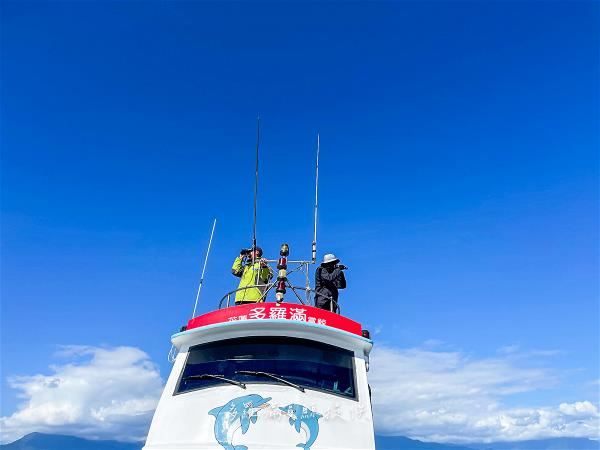
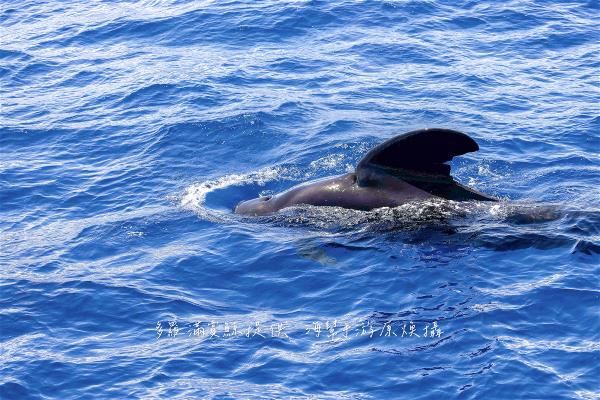
Spinning and leaping
The whale-watching boat sails out of Hualien Harbor, and in less than half an hour the first group of spinner dolphins is spotted through the binoculars, riding the waves, spinning their bodies, and leaping out of the water, all while traveling at an astonishing speed.
Liao explains, “The motion of a mechanically powered boat generates a flow of water, and cetaceans love to come up to the side of the boat and ride that flow.” Some cetaceans surface, then raise their heads to look around them. Some will playfully leap and dive into the waves, sending up a shower of spray, and when whales and dolphins begin a dive into deeper waters, they raise their tails. Sperm whales, for instance, typically dive for 30–40 minutes at a time.
Liao cites world-renowned primatologist Jane Goodall, who believes that caring for the environment doesn’t mean cheering from the sidelines or shouting slogans, but comes from visiting animals’ habitats and treating them as friends. Twenty-nine years of promoting whale watching has attracted over 10 million visitors to the sea to show their concern for cetaceans. “They are our neighbors from the sea, and like friends, we care about how they’re doing. This is how conservation awareness naturally develops.”


Rebuilding human–whale relationships
Taiwan is located on the edge of the East Asian continental shelf. The average depth of the Taiwan Strait is less than 100 meters, but on the eastern side there is an oceanic basin reaching depths of 5,000–6,000 meters, forming a large marine ecosystem. “We have shelf ecosystems, oceanic ecosystems, and three ocean currents: the Kuroshio Current in the east, the China Coastal Current in the Taiwan Strait, and the South China Sea Current in the southwest. These currents all interact in the waters near Taiwan, giving us top-notch marine biological resources, and our cetacean resources are also among the best in the world,” says Liao. Data shows that there are approximately 90 species of whales and dolphins worldwide, and 30 species—one third of the total—have been sighted around Taiwan in recent years.
Liao also explains that there are some differences between whale watching in Taiwan and whale watching abroad, which is often seasonal. In semi-enclosed marine areas, cetaceans rest, mate, and reproduce on a regular, seasonal basis that requires a less disruptive environment. Therefore, there are clear regulations for whale watching.
Taiwan’s situation is different. The Pacific Ocean off the East Coast is completely open sea, where schools of fish follow the flow of the Kuroshio Current along Taiwan’s shoreline. “So basically, whale-watching activities in Eastern Taiwan means boats taking tourists out to sea to encounter whales that are just ‘passing by.’”
Liao confidently states that since the Visit the Pacific Sperm Whale π Project began, “While sperm whales were sighted on about 13% of excursions, in 2024 that number reached 17%. In just two years, the project has confirmed that several pods of sperm whales visit our waters every year. Sperm whales can be seen in the waters off Eastern Taiwan every year from March to October, with July and August being the peak months for sightings.”

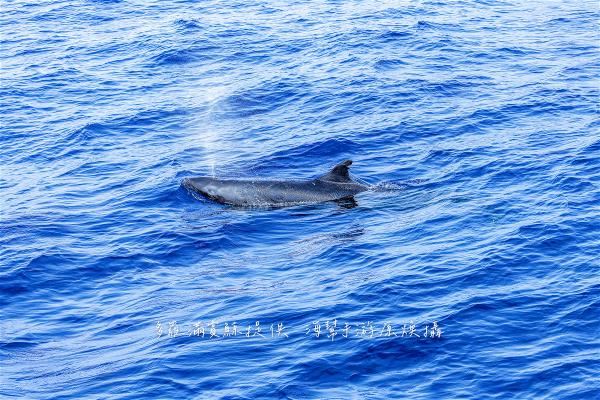
Homecoming
For over three decades, Liao Hong-chi has been involved in fishing, cetacean surveys, and marine conservation off the East Coast of Taiwan. If he were conducting land-based research, he might have already reached a certain limit. “But for me, this swath of ocean is still full of attractions. Every time I go to sea, I look forward to seeing sights I’ve never seen in my life.”
The past two years have provided a series of pleasant surprises, he says, recalling last year’s encounters with rare melon-headed whales and rough-toothed dolphins. He also saw a mother sperm whale with two calves, and says, “The calves were about three to four meters long, and you could still see fetal folds on their bodies, confirming that they had just been born.”
“That means the calves were born in the waters off Hualien,” says Liao, and jokes, “They should be able to get a Taiwanese ID card.” He goes on to explain that for such large animals to feel safe enough to give birth, they must be certain that the water temperature is appropriate, the water quality is good, and that the people nearby will not disturb them. “These animals have a habit of regularly returning to their birthplace, so we are sure they will return to Taiwan every year.”
Last year, sperm whales were also spotted gathering and resting in the waters east of Taiwan. Liao explains, “We had just happened to catch up with their leader, and he let out a command to gather around him. After hearing the command, all the sperm whale pods within a two- to three-kilometer radius gathered around their leader. Then they began to lift their heads out of the water, rising vertically and then sinking, as if holding a meeting right next to our boat. We deduced that it was a brief sleep and rest period for them. The sight of ten or 20 sperm whales appearing together is truly breathtaking.”
Although there is always a risk of coming up empty during a whale-watching trip, Liao Hong-chi likes to say, “The ocean doesn’t make advance reservations. But it’s always worth the wait, and we hope to share these amazing sights with those of you who love the ocean.”
